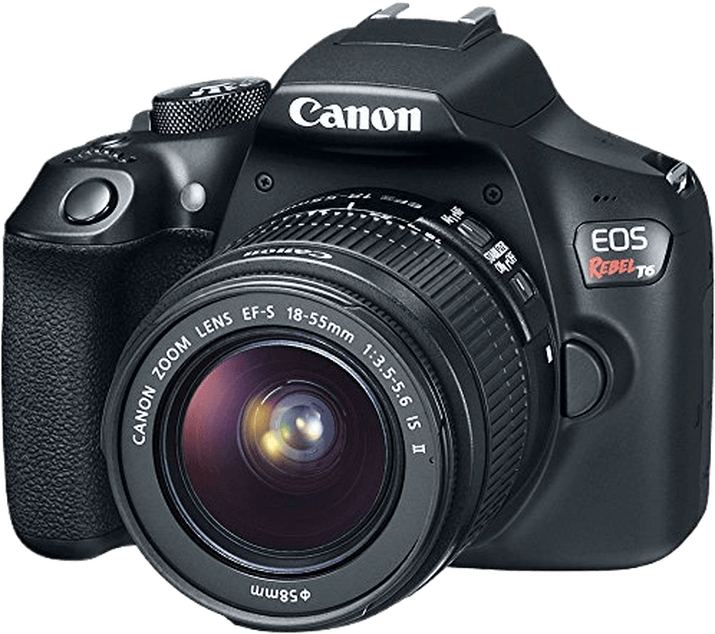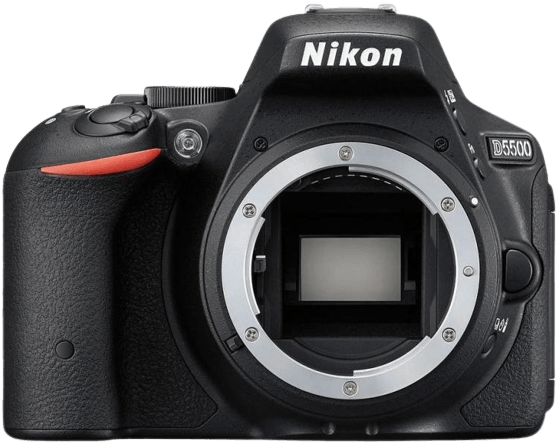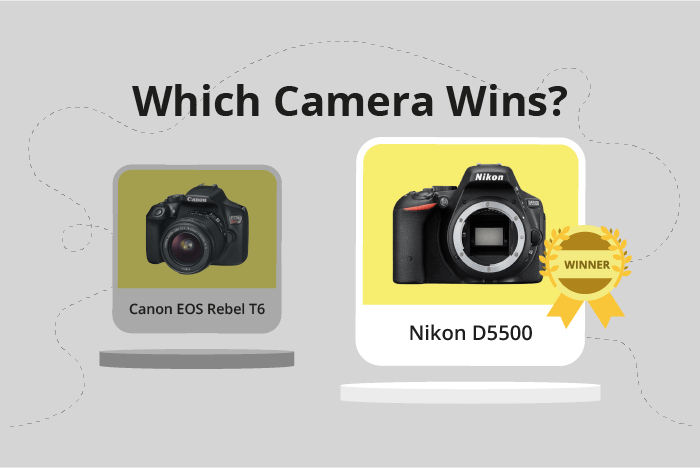Canon EOS Rebel T6 / 1300D vs Nikon D5500 Comparison
Canon EOS Rebel T6 / 1300D

Nikon D5500

The Nikon D5500 wins the comparison with a score of 61/100, while the Canon EOS Rebel T6 / 1300D trails behind at 39/100. Both cameras are DSLRs released in 2015 and 2016, with launch prices of $900 and $550, respectively. They share similarities in size, with the Nikon being slightly smaller at 124 x 97 x 70mm compared to Canon’s 129 x 101 x 78mm. The Nikon also has a weight advantage, weighing 420g/0.93lbs, while the Canon weighs 485g/1.07lbs.
The Nikon D5500 outshines the Canon EOS Rebel T6 / 1300D in various specifications, contributing to its higher score. On the other hand, the Canon EOS Rebel T6 / 1300D has a lower launch price, making it a more budget-friendly option for those who prioritize affordability.
Taking all factors into consideration, the Nikon D5500 is the superior camera in terms of performance and specifications. However, the Canon EOS Rebel T6 / 1300D may appeal to those looking for a more affordable option without compromising too much on quality.
Canon EOS Rebel T6 / 1300D vs Nikon D5500 Overview and Optics
The Nikon D5500 emerges as the winner in the optics comparison, scoring 65/100, while the Canon EOS Rebel T6 / 1300D scores 40/100. Both cameras share some specifications, such as having a CMOS sensor, APS-C sensor size, and no image stabilization. However, there are significant differences that set them apart.
The Nikon D5500 outperforms the Canon T6 in several aspects. It has a higher megapixel count of 24.2 compared to the T6’s 18 megapixels, allowing for better resolution and image quality. The D5500 also boasts a faster shooting speed of 5 frames per second (fps) compared to the T6’s 3 fps, providing an advantage in capturing fast-moving subjects. Additionally, the Nikon D5500 has a higher DXOMARK score for its sensor at 84, compared to the T6’s score of 66, indicating better overall sensor performance.
In contrast, the Canon T6 does not hold any significant advantage over the Nikon D5500 in terms of optics. Both cameras have the same sensor type and size, and neither offers image stabilization. The Canon T6’s processor, the Digic 4+, is older than the Nikon D5500’s Expeed 4 processor, which contributes to the T6’s lower shooting speed and sensor performance score.
Taking these points into account, it is clear that the Nikon D5500 is the superior camera in terms of optics. Its higher megapixel count, faster shooting speed, and better sensor performance make it a more capable camera for capturing high-quality images. The Canon EOS Rebel T6 / 1300D, while sharing some common specifications, falls short in comparison and does not offer any significant advantages in this area.
Canon EOS Rebel T6 / 1300D vs Nikon D5500 Video Performance
The Nikon D5500 clearly outperforms the Canon EOS Rebel T6 / 1300D in video capabilities, with a video score of 70/100 compared to the Canon’s 43/100. Both cameras share some common specifications, such as Full HD video resolution and maximum video dimensions of 1920 x 1080. However, there are key differences that make the Nikon D5500 a superior choice for video recording.
One of the most significant advantages of the Nikon D5500 over the Canon T6 / 1300D is its higher maximum video frame rate of 60fps, which is double the Canon’s 30fps. This allows users to capture smoother and more detailed videos, especially in fast-paced situations or when recording slow-motion footage.
Another feature that sets the Nikon D5500 apart is its built-in time-lapse functionality. This enables users to create stunning time-lapse videos without the need for additional software or equipment, making it a more versatile and convenient option for those interested in this type of videography.
On the other hand, the Canon T6 / 1300D does not offer any distinct advantages in video capabilities over the Nikon D5500. Its lower video score and lack of time-lapse functionality make it a less appealing choice for those prioritizing video performance in their camera selection.
Taking these factors into consideration, the Nikon D5500 is the clear winner in terms of video capabilities. Its higher video score, 60fps maximum frame rate, and built-in time-lapse functionality make it a more versatile and powerful option for users who are serious about capturing high-quality videos. The Canon T6 / 1300D, while still a capable camera, falls short in this specific aspect.
Canon EOS Rebel T6 / 1300D vs Nikon D5500 Features and Benefits
The Nikon D5500 emerges as the winner in the comparison of features, scoring 59 out of 100 points, while the Canon EOS Rebel T6 / 1300D scores 41 points. Both cameras share several specifications, such as having a flip screen, WIFI connectivity, and the lack of GPS and Bluetooth.
The Nikon D5500 outperforms the Canon EOS Rebel T6 / 1300D in several aspects. Firstly, the Nikon D5500 has a larger screen size of 3.2 inches compared to the Canon’s 3-inch screen. Secondly, the screen resolution on the Nikon D5500 is higher, with 1,037,000 dots, while the Canon EOS Rebel T6 / 1300D has 920,000 dots. Lastly, the Nikon D5500 has a touchscreen, which the Canon EOS Rebel T6 / 1300D lacks. These features make the Nikon D5500 more user-friendly and provide a better viewing experience.
On the other hand, the Canon EOS Rebel T6 / 1300D has a few advantages over the Nikon D5500. The Canon has a flip screen, which is a useful feature for shooting from various angles and for composing self-portraits. However, this advantage is shared by the Nikon D5500, which also has a flip screen. Therefore, the Canon EOS Rebel T6 / 1300D does not have any exclusive advantages over the Nikon D5500 in terms of features.
Considering these points, the Nikon D5500 is the superior camera in terms of features, offering a larger and higher-resolution touchscreen, while the Canon EOS Rebel T6 / 1300D falls behind in this comparison. The Nikon D5500 is the better choice for photographers looking for a camera with more advanced features and a better user experience.
Canon EOS Rebel T6 / 1300D vs Nikon D5500 Storage and Battery
The Nikon D5500 surpasses the Canon EOS Rebel T6 / 1300D in storage and battery with a score of 35/100, while the Canon scores 27/100. Both cameras share similarities in storage, having one memory card slot each and accepting SD, SDHC, and SDXC memory cards. However, the Nikon D5500 outperforms the Canon in battery life, providing 820 shots compared to the Canon’s 500 shots.
The Canon EOS Rebel T6 / 1300D uses an LP-E10 battery type, which does not offer any significant advantage over the Nikon’s EN-EL14 battery. Neither camera supports USB charging. The Nikon D5500’s extended battery life makes it a more reliable choice for longer shooting sessions.
In evaluating storage and battery capabilities, the Nikon D5500 proves to be the superior option due to its longer battery life. The Canon EOS Rebel T6 / 1300D does not offer any notable advantages in this category.
Alternatives to the Canon EOS Rebel T6 / 1300D and Nikon D5500
Are you still undecided about which camera is right for you? Have a look at these popular comparisons that feature the Canon EOS Rebel T6 / 1300D or the Nikon D5500:

